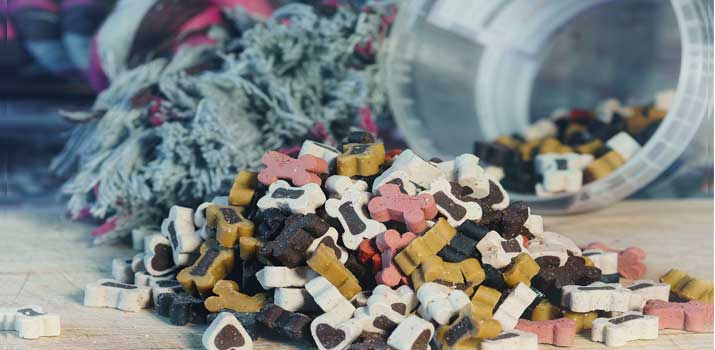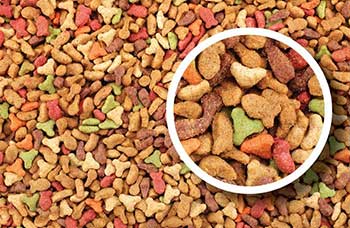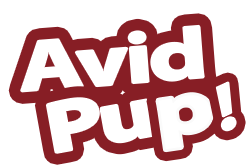
We humans go to great lengths to ensure that our food stays fresh and spoil-free. So, why not extend that same courtesy to your canine companion’s meals?
Dog food can go sour just like human-grade food. While dogs aren’t super concerned about having the freshest dinner possible, their overall health depends on it.
Those pricy kibbles and premium canned foods lose nutritional value as they go rancid.
Like any other food, it can start to decay and fall prey to mold and bacteria issues. On top of that, it might attract rodents, insects, and a host of other pests.
You’ve probably put a lot of work into choosing the best food for your dog.
Seeing all that nutritional value go to waste is a shame! Not to mention the potential health problems that come with eating spoiled food.
Storing dog food might seem simple enough. But you’d be surprised by just how many people are doing things wrong!
Proper storage is about prolonging the life of the food, retaining its freshness, and keeping it palatable for your dog.
Here’s how to properly store dog food common mistakes you want to avoid!
Why Proper Dog Food Storage is Important
Before we get into storage techniques, let’s talk about dog food spoilage as a whole.
As we mentioned earlier, suitable storage methods can keep dry kibble and wet gravy based foods in good shape for much longer.
Think of it as a bag of opened potato chips.
The longer you leave the chips out, the staler and grosser they get. The same things happen to dog food but on a more monumental scale!
Whether you go wet or dry, you’re buying nutritionally balanced food with a bevy of ingredients.
Even a single piece of the kibble might have dehydrated proteins, vegetables, and more.
These products are supposed to support your dog throughout their entire life. As a result, everything has to be fine-tuned to meet their biological needs.
Improper Storage
With improper storage, dog foods will start to lose their nutritional value.
It might not seem like a big deal at first, but providing old food is only depriving them of the macronutrients they need to stay healthy.
Furthermore, rancid food tastes and smells awful! Now, dogs aren’t known for having ultra picky palates.
They’re notorious for eating trash and dead animals, after all! However, they still appreciate tasty food.
Dogs can turn their noses up at foods that don’t meet their standards. Some dogs are pickier than others, leading to more discernible tastes as freshness is concerned.
You also have to think about safety.
Sure, modern dog foods are filled with natural and chemical preservatives that help keep spoilage at bay. But, those preservatives have their limitations.
Organic Ingredients
Dog food products of any quality will have oils, fats, and tons of organic ingredients that can’t stand the test of time forever.
Eventually, those constituents will go rancid, causing all kinds of problems for your dog if they get unlucky enough to eat the food.
On the milder side of things, they may suffer from short-term side-effects like vomiting, diarrhea, and general gastrointestinal upset. However, more serious ramifications can occur, too.
Spoilage can promote pathogen growth. Some pathogens, such as E. Coli and Botulism, can have a debilitating impact on your dog’s health. In severe cases, they can be fatal.
Bacteria is no joke and is something you need to keep your dog safe from.
The same goes for pest-carried illnesses.
Improper storage can attract a wide range of pests in your home. From benign insects to rabies-ridden raccoons, the food is nothing but a pest attractor!
Whenever a pest interacts with the food, you run the risk of spreading diseases to your dog.
What Causes Dog Food to Spoil?
The key to understanding proper storage is understanding what makes food go bad. The moment the food comes into existence, time is of the essence!
The first thing we recommend doing is taking a look at the expiration date.
The “Best By” date will give you a better idea of how long the food is capable of lasting.
This date refers to the “shelf-stable” life. After the date passes, there’s no guarantee concerning the nutrient analysis or safety of the food.
Now, it’s important to remember that this date only applies to unopened food!
Once you rip the bag open, you’ll have even less time!
That’s because opening the bag exposes you to food’s biggest enemies: Air, moisture, and high temperatures. Those three factors are responsible for spoiling food.

Air and moisture encourage the growth of microorganisms. Meanwhile, hotter temperatures create a more conducive environment for those microorganisms to flourish.
Not only that, but the oxygen exposure triggers chemical reactions within the food. Ingredients oxidize, leading to that stinky smell and flavor.
When you store food, those are the three factors you need to take into account.
Air, water, and high temperatures are what you have to protect the food from.
Unopened dry foods usually have an unopened shelf life of about 12 to 18 months. Canned foods may last up to two years.
However, opened food has a dramatically shorter lifespan.
There are ways to prolong its freshness, but as a good rule of thumb, try to use it all up within a month of opening the bag.
Storing Dry Dog Food
Dry kibble is the go-to for most dog owners because of its simplicity and convenience.
These foods are shelf-stable in the right conditions and can last a pretty long time with suitable storage techniques. But like any other food, they’re not indestructible!
Find a Suitable Spot
After looking at the “Best By” date, you should find a cool, dry spot. Avoid any areas of your home that have fluctuating temperatures or super humid air quality.
Ideally, the right storage spot should be air-conditioned and stable.
One good option is your pantry. The right storage spot won’t stop spoilage alone, but it can do a lot to combat issues related to temperature and humidity.
Create an Airtight Seal
The next thing you’ll need to do is create a seal! The worst approach is to leave the bag open or loosely covered.
Even if the kibble is inaccessible by pests, the air exposure will wreak havoc on its overall quality.
The best approach is to “vacuum seal” the bag. Now, you can go above and beyond with this by using a real vacuum sealer to get rid of excess air.
That’s the best method. But if you’re like most, you’re not going to have a professional sealer at your disposal!
In that case, a clip will work just fine. Roll the top down to push any extra air out and clip the opened side together.
Alternatively, you can also use an airtight container. Pop the entire bag into the container and attach the lid to keep everything safe.
Dealing with Bulk
Many veterinarians recommend that you only buy enough food to last your dog a month. That way, you can get through the supply before natural spoilage can take effect.
But what if you like to buy in bulk?
Bulk purchases are very economical, allowing you to get nutrient-rich food at only a fraction of the cost.

Before you pay for tons of food, there are a few things to look into. The first is the expiration date.
Some stores will put dog foods on sale to get rid of stock that will expire soon. If that’s the case for the food you’re interested in, avoid it.
There’s a higher chance that the food will go bad before your dog gets to eat it.
Secondly, make sure you have enough room in your freezer! The best way to store bulk food is to pop it in the freezer.
In lower temperatures, bacteria can’t flourish, so you can realistically keep dog food in the freezer for several months.
Portion everything out in individual bags, remove the excess air, and let it freeze.
Whenever you need to use it, let the food thaw out for several hours at room temperature on the same day, and you’re good to go!
Storing Wet Dog Food
Keeping canned wet food fresh is a bit trickier than its dry counterpart.
Sure, the metal storage vessel is fantastic for long-term storage in a pantry. But once you open it, you have only a few hours before spoilage occurs!
Wet food should never sit out at room temperature for more than four hours.
If your dog doesn’t eat the food immediately, you need to take action to prevent bacteria and mold from taking hold.
Create an Airtight Seal
If you have leftovers, you’ll need to find a way to prevent air from affecting the food.
Place the food in an airtight container or plastic bag. You can also find rubber or silicone lids that create an airtight seal over opened cans.
Refrigeration and Freezing
Once the food is protected from oxygen, pop it in the refrigerator. This is crucial with wet food.
Whether the food is a mash or has large chunks of meat in gravy, it already has a high moisture content.
Even at room temperature, there’s a good chance that it will develop bacteria and mold.
In the fridge, the food will last about three or four days. For long-term storage, keep it in the freezer. Just thaw it out whenever you’re ready to feed it to your dog.
10 Storage Pitfalls to Avoid
The quality and safety of your pup’s food should always be a top priority. While dog food storage seems simple enough, you’d be surprised at how easy it is to do things wrong!
Even with the best of intentions, some dog owners may inadvertently make things worse! Here nine of the most common dog food storage mistakes that pet parents make.
1. Dumping a Bag of Dog Food Into a Container
This is a pretty easy mistake to make. You have a separate airtight container and a brand-new bag of kibble. It makes sense to dump the kibble and toss the manufacturer’s bag, right?
Well, this poses a couple of problems. First, the bag that the food comes in is specially-made for longevity.
It features an oil-resistant coating inside, which helps to retain flavor and freshness.
Secondly, dumping the food into the container may increase its exposure to bacteria. Oil from the last batch can linger behind, affecting the new one. Plus, bacteria can hide in scratches!
Finally, tossing the original bag gets rid of some valuable information?
What if your dog gets sick? What if the manufacturer recalls the product? What if you need some information about your dog’s diet for your vet?
All of that data is on the bag. If you get rid of it, you’ll be lost in the dark!
2. Container Top Ups
Many of us are guilty of this. Your dog food supply is getting low, so you buy another bag and top the container up so that you’re never without food.
It seems responsible enough. But, you may end up accumulating rancid oil and spoiled crumbs instead.
Always use up all of the food in an airtight container before you add more. Once it’s empty, wash it out to remove any leftover bits. Then, you can add your new food.
3.Keeping Dog Food in the Garage
Think about the environment in your garage for a second. Chances are, it’s not connected to your home’s HVAC system. As a result, it probably gets hot and humid during the day.
That’s the last thing you want for your dog’s food!
Excess heat will break down oils and invite pathogens to flourish. Dog food does best in cool and dry places.
4. Not Using a Clip
You’re in a hurry, so after giving your dog their meal, you roll up the bag of food and go about your way. A loose roll does enough to keep the bag closed, right?
Hate to break it to you, but not using a clip can speed up the spoiling process!
Clips aren’t leakproof by any means. But, they can significantly limit how much air is getting in. They restrict airflow, keeping the food fresh for longer.
Not only that, but clips make it harder for hungry pests to get in!
5. Not Washing Food Bowls
When was the last time you washed your dog’s food bowl? Would you use the same plate day after day without washing it?
The oils in your dog’s food will accumulate and coat the bowl. It can then go rancid, souring any new meal you put in!
According to the FDA, you should clean your dog’s bowl after every single meal.
It’s also essential to wash out airtight storage containers once they are emptied.
6. Keeping Dog Food Outside
You should never leave open dog food or containers outside. Like your garage, the outdoors is unpredictable.
Even in a premium storage container, there’s a risk of fluctuating temperatures and pest exposure.
Don’t make the mistake of thinking that you can just keep it under some shade. Always keep dog food in a cool room with stable temperatures.
7. Ignoring the Expiration Date
Seriously, you should always look at the expiration date before you buy anything. Don’t trust the store to carry non-expired foods.
That might seem pessimistic, but things go under the radar all the time. This is especially true with shelf-stable products like dog foods.
Even if the store just got a fresh stock, what’s to say that the food didn’t sit in a warehouse for a full year before getting there?
Pay attention to the expiration date and avoid anything that’s even close to going bad.
8. Forgeting the Label
This mistake applies to frozen foods or products you end up putting in the refrigerator for a few days.
You need a label to get accurate information about the food and its stability. Jot down when you opened it. It’s also a good idea to provide the manufacturer’s expiration date.
That way, you can organize feedings and focus on foods that have the shortest time left.
9. Leaving Food Out for Too Long
Sometimes, dogs just aren’t hungry at the moment. There’s nothing wrong with that!
However, you have to make sure that you’re not leaving food out for too long.
Canned foods only have a few hours before they start spoiling. Even dry food will start to turn rancid!
Give your dog the opportunity to eat. But if they’re not taking the food, put it in the refrigerator to preserve its freshness.
10. Buying Too Much
There’s nothing wrong with buying dog food in bulk. But if you don’t have the means to store it properly, you may be doing more harm than good.
Many dog owners see their pup’s favorite food on sale and end up snatching as many bags as they can!
But then, they realize they don’t have the freezer space available. So, it just ends up going bad anyway.
Only buy food in bulk if it makes sense for your lifestyle.
Conclusion
Storing dog food isn’t so cut and dry as you might think. There’s a lot that can go wrong!
When it comes to your dog’s health and safety, you should never cut corners. Pay attention to how you store your dog’s food and see where you can improve.
Taking a few extra steps to keep the food fresh can make all the difference.
Also Read: Dog Won’t Eat Her Food But Will Eat Treats

